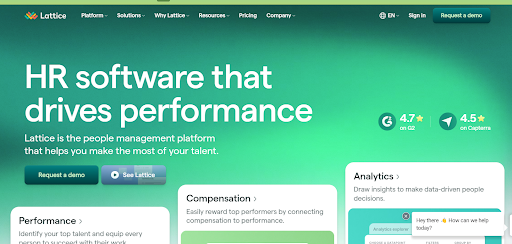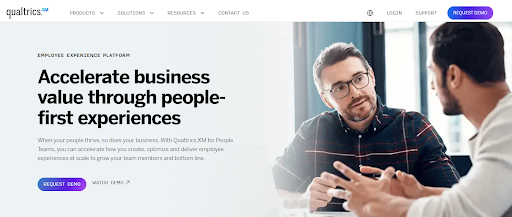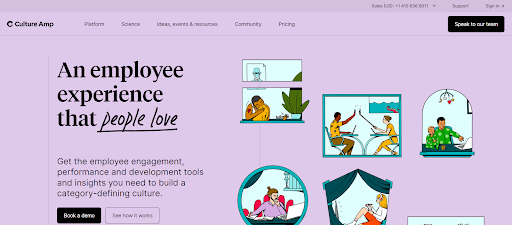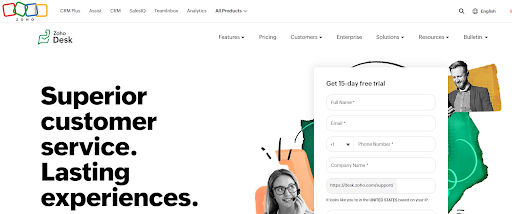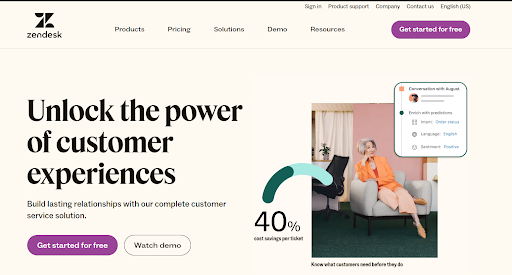Employee experience software: A guide for people-centric HR professionals
An excellent employee experience is critical to retaining and satisfying top talent – and there’s a lot to it.
Employee experience is about the entire employee journey, so you must provide solid recruitment, onboarding, and development.
You need a significant amount of time and effort to do it right for even one employee, but what about fifty, one hundred, or even one thousand?
You can’t juggle it by yourself – you need employee experience software.
This software helps HR professionals manage every step of the employee lifecycle, enabling them to optimize employee development, oversee data and analytics, and automate manual tasks.
In turn, it improves employee satisfaction, driving the customer experience and employee retention.
You can streamline your employee experience strategy easily with this HR technology, no matter how many workers you have on staff.
This article dives into the importance of employee experience management software and the five best practices to use it effectively. It also lists our top five picks of the best software available.
Table of contents
- What is employee experience software?
- Why are employee experience platforms important to HR professionals?
- The benefits of employee experience tools
- 5 best employee experience software
- 5 best practices for leveraging employee experience software in your HR department
- 3 examples of companies succeeding with digital employee experience platforms
- Make the journey worthwhile with employee experience software
- Employee experience software FAQs
What is employee experience software?
Employee experience software refers to tools for improving the overall employee lifecycle, from attraction to departure. These platforms improve the employee journey by enhancing communication, development, and collaboration.
These tools don’t have one specific use – instead, they aim to improve how employees interact with work daily.
Employee experience platforms have many possible features, from having a central hub to access tools to providing an HR chatbot to answer questions.
Employee experience tools are an HR technology trend worth addressing. They help engage and retain top talent and can be used with other software to make a larger impact.
For example, you could use VR training tools and employee experience software to manage progress and development.
Why are employee experience platforms important to HR professionals?
The war for talent has employers striving to provide the best employee experience possible to attract and retain great employees. Employees want a great place to work, develop, and collaborate and often keep looking until they find one.
Even if employees stay at your company, a negative experience might cause them to resort to accomplishing the bare minimum, also known as quiet quitting.
This sense of dissatisfaction has a significant impact:
Six in 10 employees are quiet quitting
51% of employees are watching for or actively seeking new work
41% of employees say they need better engagement and work culture
You want to ensure your employees won’t find better opportunities, but it’s more than that – providing an excellent employee experience makes your company more likely to attract employees looking for a better job, too.
The number of workers also affects the driving need for employee experience software. As organizations scale, providing a great employee journey for each worker becomes increasingly difficult.
It’s tricky enough for HR teams to handle recruitment platforms and basic people management with rapidly growing teams, let alone manage development and make strategic decisions.
Digital employee experience software is also important to modern companies because it improves business outcomes. These tools create a smoother experience for employees, enabling them to better serve customers and collaborate with their teams more effectively.
Employee experience management software helps you uphold a strong employee value proposition (EVP), a promise you make to your staff in return for their hard work and loyalty.
A solid EVP includes fair compensation, benefits, work-life balance, and career stability – all of those points are easier to provide and manage with the right tools.
For more information on this subject, read our post on how to build a strong employee value proposition.
The benefits of employee experience tools
The best employee experience platforms improve the employee experience and make life easier for HR professionals.
Integrating these tools into your HR tech stack improves collaboration and data management and helps you make strategic business decisions.
1. Centralize data management
An employee experience management platform centralizes your data and work tools, making it easier for HR professionals to manage their employees and simpler for employees to get answers to their questions.
Employees spend an average of 3.6 hours per day searching for information. This search makes 31% of workers feel burnt out, and 16% consider leaving their organization.
Almost 60% of employees blame this search on having too many sources of information to sift through.
A central hub of information and data eliminates this headache and improves productivity because 30% of working hours are otherwise lost looking for information.
2. Improve collaboration and productivity
Employee experience tools improve communication and collaboration between individuals and teams.
It strengthens communications between employees and managers and increases visibility between managers. For example, it’s simpler to identify development opportunities and reward high-performers.
Hard work is always recognized, and no effort slips by unnoticed.
The engagement from this collaboration also has a direct, positive impact on:
Productivity
Profitability
Quality
Absenteeism
Turnover
It might be a bit trite to say that communication is key, but better collaboration and teamwork improve a work environment tenfold.
3. Facilitate excellent employee development
Employee experience software helps you monitor performance, promoting healthy development. It helps you identify high performers and struggling employees with improvement areas.
Monitoring performance also assists your onboarding process. These tools, in combination with great employee onboarding software, help new hires ramp up and adjust to their new environments faster.
Harnessing employee experience tools promotes a culture of feedback, enabling you to easily relay real-time feedback to staff and encourage their feedback in return through easy employee pulse surveys.
Your workforce thrives off of feedback.
Employees who receive weekly feedback are three times more likely to strongly agree they are motivated to do outstanding work and twice as likely to be engaged at work.
4. Improve decision-making with advanced analytics
Companies can identify the effectiveness of their initiatives and strategies by monitoring data insights.
Digital employee experience platforms monitor many useful metrics, such as:
Engagement levels
Retention
Turnover
Motivation
Job satisfaction
Business leaders who take advantage of analytics say they better understand their workforce’s needs than those who don’t, yet 42% of companies aren’t using analytics.
This data can help inform your hiring decisions and development programs in many ways, such as when to post a job ad and how long to wait until you review applicants.
5 best employee experience software
Adopting employee experience software as soon as possible is critical, but the decision-making process can be overwhelming.
We’ve narrowed down the choices to our favorite five engagement tools. Let’s look at the pros and cons of each system, as well as their pricing and rating from a top software review site.
Factors we considered
Here’s a quick summary of what matters when picking a tool for your organization:
Workflows. How smooth and simple is it for employees to connect their actions and tools and get their work done?
Data and analytics, which help you monitor essential employee metrics and KPIs, such as engagement and retention.
Integrations. An employee experience platform should integrate with your existing tech stack, such as communication channels, intranet, HRIS software, or a mobile app.
Automation and AI. HR automation enables you to streamline tedious tasks and increase productivity. It’s also important to look for AI predictive analytics, which help you forecast future needs and opportunities.
Feedback and listening. The best employee experience platforms enable you to effortlessly send surveys and monitor the opinions of your staff.
The best employee experience platforms
Software | Key features |
1. Lattice | - All-in-one system - Detailed analytics - Excellent employee recognition features |
2. Qualtrics EmployeeXM | - Detailed data insights - Easily collect and export data - AI-driven predictive analytics |
3. Culture Amp | - Goal-setting and goal-tracking - Easily build development plans - Simple employee feedback features |
4. Zoho Desk | - Employee experience software with customer service capabilities - Chatbots and knowledge bases provide helpful information - Streamlined workflows |
5. Zendesk | - Deep customization - Enhanced communication - User-friendly interface |
1. Lattice: Best overall
Lattice is a powerful all-in-one HR system that offers a wide range of features.
This software helps you send surveys, encourage employee development, and manage performance and compensation. It offers robust, detailed insights, enabling you to use valuable people data to inform your strategy and decisions.
Lattice focuses heavily on employee listening, facilitating one-on-one meetings, feedback, and recognition. It has built-in employee recognition software that enables you to send personalized, public recognition messages.
Pros | Cons |
- Streamlines feedback and development - Many third-party integrations like Slack and Microsoft Teams - Easy to use - Versatile, intuitive workflows | - Too many features can make it complicated or confusing - Interface is difficult to navigate |
Rating: 4.7 out of five (G2)
Pricing at time of writing: Starts at $8 per user per month
2. Qualtrics EmployeeXM: Best for data and analytics
Qualtrics EmployeeXM is user-experience software with advanced data and analytics.
This software focuses on building and analyzing people's data. It makes it simple to collect, analyze, and export insights straight from your HR dashboard so you can work on making strategic improvements after employees reach certain milestones.
Qualtrics EmployeeXM also uses AI-driven predictive analytics to take action, such as understanding survey results and feedback.
Pros | Cons |
- AI makes smart predictions and suggestions - Easily personalized survey tools - Premade templates to get you started quickly - Streamlined workflows | - Difficult to afford for SMEs with its current pricing structure - Steep learning curve |
Rating: 4.4 out of five (G2)
Pricing at time of writing: Starts at $75 per month
3. Culture Amp: Best for employee development
Culture Amp is an effective tool to help you grow and empower your workforce.
This tool provides detailed goal-setting and tracking, easy feedback, and quick reviews of previous one-on-one meetings.
Culture Amp also helps HR professionals build personalized employee learning plans and harness valuable learning and development data, including trackable growth goals and learning reports.
This software also encourages growth through team interactions by promoting peer-to-peer recognition and feedback.
Pros | Cons |
- Easy growth monitoring and management - In-depth, real-time reporting and analytics - Smooth, centralized workflows | - Limited customization options - Hard to find old feedback and advice in the system |
Rating: 4.5 out of five (G2)
Pricing at time of writing: Starts at $11 per user per month
4. Zoho Desk: Best value for money
Zoho Desk is employee engagement software with customer service operations features.
This affordably priced tool offers streamlined workflows, data insights, employee self-service features like chatbots and databases, and easy-to-read performance reports.
Zoho Desk also has payroll software modules, such as a payroll help desk.
Pros | Cons |
- Great workflows - Detailed data and analytics - Helpful chatbots and knowledge bases - Great customer support | - Over customization and too many features - Lack of customization for lower subscription tiers |
Rating: 4.4 out of five (G2)
Pricing at time of writing: Starts at $7 per user per month
5. Zendesk: Best for total customization
Zendesk is a powerful employee experience platform with deep customization capabilities.
This software offers detailed customization on automation, workflows, ticketing, and white-labeling, including the overall layout.
Its user-friendly interface, combined with its specific customization, enables you to create a tailored experience for your workforce, making their jobs easier.
Zendesk also provides feedback channels, conversation logs, and AI chatbots to answer your staff’s questions.
Pros | Cons |
- Highly customizable - Easy-to-use - Detailed data and analytics - Easy-to-access knowledge bases | - Difficult customization without coding knowledge - Expensive |
Rating: 4.3 out of five (G2)
Pricing at time of writing: Starts at $19 per user per month
5 best practices for leveraging employee experience software in your HR department
As you finalize your decision, take a moment to read our best practices and learn how to take advantage of everything employee experience tools have to offer.
Employee experience software strategies
Strategy | What it accomplishes |
1. Leverage employee self-service features | Empowering team members helps them answer their own questions and increases their autonomy |
2. Promote team collaboration and trust | Encouraging feedback and collaboration promotes trust and psychological safety |
3. Encourage and monitor employee development | Assisting development increases satisfaction and boosts your employer branding |
4. Use predictive analytics and employee surveys | Deep workforce insights help you make better decisions and improve your company |
5. Find a balance between AI and human processes | Knowing when to use AI helps you save time but also remember the human side of HR |
1. Leverage employee self-service features
Employee self-service features are an excellent addition to any HR software, but they especially help improve the employee experience.
Self-service tools give employees ownership of their duties and roles, empowering them to seek and find the information they need.
This process encourages autonomy, an increasing demand among employees, and is a powerful driver behind other workforce trends, like remote work.
Features like large knowledge bases and HR chatbots help workers answer their own questions, increasing their job satisfaction and engagement. Further, they also help them get the information they need faster, improving their performance and productivity.
Consequently, this process also eases the burden on HR, enabling your team to solve more complicated issues in the workspace and leave the simple questions to your software.
2. Promote team collaboration and trust
Employee experience management software supplies many ways to promote better collaboration and communication, which increases employee well-being.
These platforms enable you to review past conversations and reflect on previous one-on-ones, helping you understand your workforce and build better relationships. You can use this information to help your employees grow and develop.
Employee experience apps also encourage employees to give and request feedback, which helps support company values like feedback and recognition.
When you establish a psychologically safe workplace where employees can share their voices, you create an organization where people grow and business practices improve.
Using employee experience platforms to ask for employee opinions also builds a culture of trust. Employees can relax and trust in their employer when they know they can freely and easily express themselves without the risk of punishment.
3. Encourage and monitor employee development
A digital employee experience platform includes many ways to encourage employee development:
Set and track goals
Schedule one-on-ones
Provide quick feedback
Monitor onboarding progress
Identify upskilling opportunities
Monitor reskilling progress
Create a recognition program and reward system
To get the most out of your employee experience software, we recommend using it with talent assessments.
Candidate assessment software isn’t just for the recruiting stage – these assessments are extremely useful for monitoring performance progress.
We recommend testing employee skills throughout their training process to track development.
For example, you can use employee experience software to set and track a worker’s career goals and verify their skills with talent assessments before moving them into a new role.
These two tools combined can build a culture of continuous learning, which enhances the employee experience and boosts your employer branding.
4. Use predictive analytics and employee surveys
Traditionally, properly capturing workforce information and making informed decisions has been difficult or impossible. However, collecting and acting on your employees’ opinions with digital employee experience software is easy.
HR analytics software enables you to review your processes and take an employee-centric, data-first approach to improving employee experience and job satisfaction.
Take advantage of a variety of surveys to gather vital feedback, such as:
Pulse surveys and check-ins
Exit surveys
Onboarding surveys
Engagement surveys
Development surveys
This data helps you build a strategy around your current needs, but you can also strategize your future by harnessing predictive analytics.
These AI-driven, actionable insights help you predict and prevent employee turnover, burnout, and disengagement.
Artificial intelligence is an incredibly useful tool for HR functions, but you must use it responsibly and only for suitable tasks. Let’s talk about that next.
5. Find a balance between AI and human processes
Finding the right balance between AI and automation and human skills is critical because it enables you to achieve the best results and better business outcomes.
A top concern in using AI is that it could take the “human” out of “human resources.” You can address this head-on by being mindful of how you use it.
Use AI to answer simple questions via chatbots, streamlining work and productivity. You can also use AI predictions to forecast future work needs.
Using artificial intelligence to answer quick questions and handle complicated analytics opens your HR team up for meaningful conversations, development, and conflict resolution.
The right amount of AI and automation gives HR professionals a stronger emphasis on people over processes. They can use their time and energy on their workforce, not on tedious tasks.
For more insights on this topic, check out our article on AI in HR.
3 examples of companies succeeding with digital employee experience platforms
The best employee experience platforms make a real difference in the organizations that use them – these companies are proof.
Let’s look at three organizations using an employee experience solution to show great results and inspire your strategy.
Muck Rack
Consumer Cellular
Omio
Muck Rack
Muck Rack, a public relations management software company, needed to level up its human resources department.
The company had HR policies that worked to a point, but they soon realized that the policies wouldn’t be sustainable as the company grew – they needed standardized and scalable practices.
Muck Rack found solid employee experience software and got right to work.
More frequent feedback and enhanced employee development was needed, so they used an engagement platform to weave engagement surveys, employee performance reviews, and rapid communication into its strategy.
Muck Rack is also rolling out regular pulse surveys to capture employee feedback about less important things.
This company uses data and analytics to examine its workforce and build detailed action plans about what needs work, what they’re doing well, and where the opportunities are.
This employee experience software is one of Muck Rack’s most important pieces of remote working technology, helping the company build a robust, cohesive culture.
Consumer Cellular
Consumer Cellular, a wireless provider, faced a critical leadership skills gap that heavily affected retention. Managers lacked a simple way to receive direction and feedback, stifling their growth.
Michelle Greenfield, a learning and professional development expert working with Consumer Cellular, realized that focusing on manager development and learning would help address this damaging turnover.
Alongside Consumer Cellular, Michelle used employee experience software to double down on one-on-ones and feedback to provide more growth opportunities to developing leaders.
She also used surveys to discover important insights and secure executive buy-in for the leadership program.
Here are the company’s results:
25% drop in employee attrition
7% increase in productivity
An eight-point rise in actioning metrics
This program also opened the company to increased collaboration and communication and a culture of continuous learning.
Omio
This travel company suffered from the slowdown in travel during the early 2020s. They faced high attrition, low engagement, and a lost sense of belonging.
Omio adopted employee experience software and found immediate shocking results. The team’s first survey showed an unfortunate 40% attrition rate and only a 41% engagement rate.
The HR team saw this data and took immediate action to make improvements.
The business issued surveys and practiced thorough employee listening to identify the issues and target each one specifically. For example, employees were concerned about how remote work policies would play out, so HR rolled out a clear remote policy.
Omio continued to target each concern and act on them, and by its following engagement survey, it discovered a 23% drop in employee attrition and a 33% increase in employee engagement.[1]
Make the journey worthwhile with employee experience software
Employee experience management software is an excellent way to leave a lasting impression on every worker, from attraction to departure.
Use these tools to enhance collaboration, encourage development, and monitor critical data and analytics. They give you essential visibility into your workers’ satisfaction and overall performance.
To learn how to monitor productivity and growth data, read our guide on performance management systems.
Want to learn more about measuring performance and skills with TestGorilla talent assessments?
Watch a live demo of our skills assessments, or sign up for a free account today!
Employee experience software FAQs
To finish up, let’s address a few frequently asked questions.
Is employee experience a part of HR?
HR is responsible for many parts of the employee lifecycle, including recruiting, development, and departure. Human resources play a crucial role in the employee experience.
Who owns employee experience?
Human resources are responsible for improving the employee experience, but other parties are also accountable.
Employees are responsible for ensuring a positive experience, managers provide essential incentives and encouragement, and leadership offers a good company culture.
What’s an employee experience strategy?
An employee experience strategy is a plan to improve employee sentiment within the company. It focuses on addressing employee needs, such as development, taking action on feedback, and providing a positive environment.
Employee experience apps help you carry out these strategies effectively and efficiently.
How does technology improve the employee experience?
Technology improves employee experience by giving employees the tools they need to complete their jobs during their workday. Tools like software and laptops are a vital part of an employee’s work.
It’s just as important for HR to have the right tech. Employee experience management software enables HR teams to create a solid employee experience quickly and easily.
Source
"How a data-driven employee experience strategy helped Omio scale through a crisis". Culture Amp. Retrieved January 22, 2024. https://www.cultureamp.com/case-studies/omio
Related posts
You've scrolled this far
Why not try TestGorilla for free, and see what happens when you put skills first.
Latest posts
The best advice on pre-employment testing, in your inbox.
No spam. Unsubscribe at any time.

Hire the best. No bias. No stress.
Our screening tests identify the best candidates and make your hiring decisions faster, easier, and bias-free.
Free resources
This checklist covers key features you should look for when choosing a skills testing platform
This resource will help you develop an onboarding checklist for new hires.
How to assess your candidates' attention to detail.
Learn how to get human resources certified through HRCI or SHRM.
Learn how you can improve the level of talent at your company.
Learn how CapitalT reduced hiring bias with online skills assessments.
Learn how to make the resume process more efficient and more effective.
Improve your hiring strategy with these 7 critical recruitment metrics.
Learn how Sukhi decreased time spent reviewing resumes by 83%!
Hire more efficiently with these hacks that 99% of recruiters aren't using.
Make a business case for diversity and inclusion initiatives with this data.

